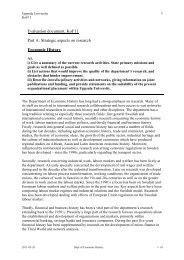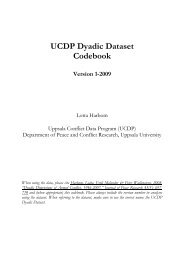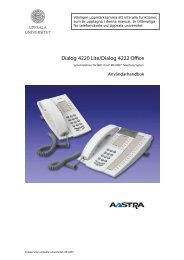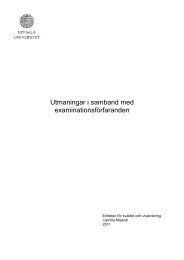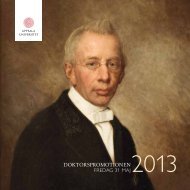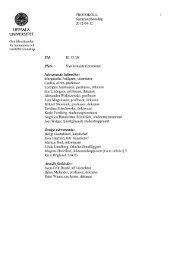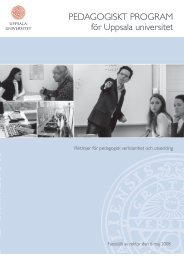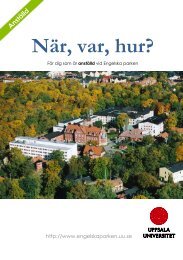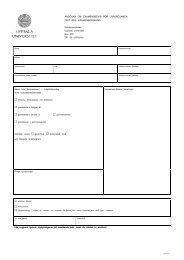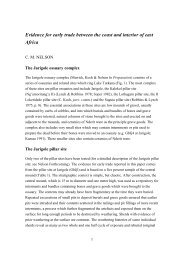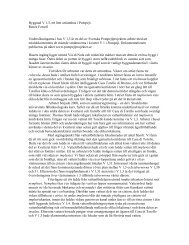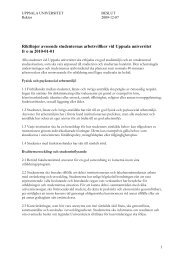Climate and Coinage
Climate and Coinage
Climate and Coinage
You also want an ePaper? Increase the reach of your titles
YUMPU automatically turns print PDFs into web optimized ePapers that Google loves.
<strong>Climate</strong> <strong>and</strong> <strong>Coinage</strong>Social Crisis <strong>and</strong> Political Conflict2 nd International LEO Conference(LEO II)Uppsala University,November 5 th –6 th 2009
<strong>Climate</strong> <strong>and</strong> <strong>Coinage</strong>Social Crisis <strong>and</strong> Political Conflict2 nd International LEO Conference(LEO II)Uppsala University,November 5 th –6 th 2009Hosted by the Department of Archaeology <strong>and</strong> Ancient History
Introduction........................................................................................................................ 3Conference Organizing Committee ......................................................................................... 4Acknowledgements.................................................................................................................... 4Conference Program – LEO II.......................................................................................... 5Day 1........................................................................................................................................... 5Day 2........................................................................................................................................... 6Abstracts ............................................................................................................................. 7Ragnar Hedlund........................................................................................................................ 7Joseph A. Tainter ...................................................................................................................... 8Lennart Lind ............................................................................................................................. 9Fern<strong>and</strong>o López Sánchez........................................................................................................ 10Hans Lejdegård....................................................................................................................... 11Richard W. Burgess ................................................................................................................ 12Peter Guest............................................................................................................................... 13Morten Axboe.......................................................................................................................... 14Helle W. Horsnæs.................................................................................................................... 15Gareth Williams ...................................................................................................................... 16Nancy L. Wicker ..................................................................................................................... 17Bo Gräslund............................................................................................................................. 18Helena Victor........................................................................................................................... 19Svante Fischer ......................................................................................................................... 20List of Participants – LEO II........................................................................................... 21The 1 st international LEO conference 2008 (LEO I): Summary................................... 22List of Papers Presented – LEO I 2008 ................................................................................. 22List of Participants – LEO I................................................................................................... 22Front cover photo: RIC X 803 reverse depicting Leo II <strong>and</strong> Zeno.SHM 23664, LEO 570, Åby hoard, S<strong>and</strong>by Parish, Öl<strong>and</strong>, Sweden.Photo courtesy of KMK.2
Introduction<strong>Climate</strong> <strong>and</strong> <strong>Coinage</strong> – Social Crisis <strong>and</strong> Political Conflict (LEO II)2 nd International Conference hosted by LEO, a research frame within the UrbanMind Project, Uppsala University, November 5 th –6 th , 2009.LEO—Liber excelsis obryzacusque—”The Elevated Book of Pure Gold” is aresearch frame of the Urban MindProject, which is affiliated with theIHOPE (Integrated History of thePeoples of Earth) project. LEO has beenconceived by Dr Svante Fischer <strong>and</strong> DrHelena Victor of the Department ofArchaeology <strong>and</strong> Ancient History ofUppsala University. LEO encompasses anumber of databases of gold solidi, thebasis for the Late Roman state finances.Currently, there are some 7,000individual solidi <strong>and</strong> some 180 hoardswith 22,000 solidi on record within theLEO research frame.The aim of LEO is to see to whatdegree climate aberrations, politicalconflict <strong>and</strong> urban crisis, <strong>and</strong>development in Rome <strong>and</strong> its successorConstantinople could be effectivelymanaged by means of state financesfrom the late 4 th century to the mid-6 thcentury.The purpose of the 2 nd internationalconference, <strong>Climate</strong> <strong>and</strong> <strong>Coinage</strong> (LEOII), November 5 th –6 th , 2009, with papers<strong>and</strong> participants from universities <strong>and</strong>museums in Britain, Canada, Denmark,France, Germany, Spain, Sweden, <strong>and</strong>the United States, is to emphasize theimportance of underst<strong>and</strong>ing social crisis<strong>and</strong> political conflict in the Late Romanworld in relation to other independentfactors. The submitted papers allhighlight a number of crucial aspects ofthe Late Roman period as it faced itsgreatest challenge ever in the late 5 thcentury—a combination of barbarianonslaught, societal decay <strong>and</strong> resilienceduring an era with a challenging climate.LEO Frame homepage: http://www.arkeologi.uu.se/UrbanMind/frames/leo.htmUrban Mind Project homepage: http://www.arkeologi.uu.se/UrbanMind/index.htmIHOPE home page: http://www.aimes.ucar.edu/ihope/3
Conference Organizing CommitteeSvante Fischer (Chair, Editor), Helena Victor (Editor),Fr<strong>and</strong>s Herschend, Hans LejdegårdAcknowledgementsFunding has been provided by:Royal Swedish Academy of Letters, History <strong>and</strong> Antiquities (KVHAA)Swedish Central Bank Tercentenary Foundation, StockholmUppsala UniversityThe Organizing Committee wishes to extend its thanks to the following institutions:Department of Quaternary Geology, Stockholm UniversityKalmar County Museum (KLM), KalmarMusée d’Archéologie Nationale (MAN), Saint-Germain-en-LayeMuseum Gustavianum, UppsalaRoyal Coin Cabinet (KMK), StockholmRoyal Swedish Academy of Letters, History <strong>and</strong> Antiquities (KVHAA)Societas Archaeologica Upsaliensis (SAU), UppsalaStockholm County Museum (SLM), NackaStockholm Resilience Centre, StockholmSwedish Central Bank Tercentenary Foundation, StockholmUppsala University Coin Cabinet (UUMK), Uppsala4
Conference Program – LEO IIDay 1.Location: Engelska Parken, Building 6, Room 003109.30–10.15 Arrival <strong>and</strong> Reception, CoffeeIMorning Session: Roman <strong>Coinage</strong> in the 4th CenturyChair: Hendrik Mäkeler10.15–10.30 Fr<strong>and</strong>s Herschend: Introduction.10.35–11.05 Ragnar Hedlund: Enriching the Soldiers? Reasons for the Striking of Gold <strong>Coinage</strong>in the Second Half of the 3 rd Century AD.11.10–11.40 Joseph A. Tainter: Mathematical Modeling of the Debasement of the Roman SilverCurrency.11.45–12.15 Lennart Lind: 1 st <strong>and</strong> 2 nd -century Denarii in a Migration Period Context: Why?12.20–13.00 Discussion13.00–14.00 LunchIIAfternoon Session: The Political <strong>and</strong> Social Crisis of the Late EmpireChair: Mats Cullhed14.15–14.45 Fern<strong>and</strong>o López Sánchez: The Western Mints in the 5 th <strong>and</strong> 6 th Centuries.14.50–15.20 Hans Lejdegård: Aspects of Ideological Resilience in the 5 th -century Roman West.15.20–15.45 CoffeeIII15.45–16.15 Richard W. Burgess: Salus Reipublica: The Reign <strong>and</strong> <strong>Coinage</strong> of Anthemius (467–472).16.20–16.55 Peter Guest: The Abrittus Hoard <strong>and</strong> the Use of Solidi in the 5 th Century.17.00–18.00 Discussion19.00–23.30 Evening banquet5
Conference Program – LEO IIDay 2.Location: Engelska Parken, Building 6, Room K 003309.00–09.30 Morning coffeeIMorning Session: <strong>Coinage</strong> <strong>and</strong> Bracteates of Barbaric Successor KingdomsChair: Ola Kyhlberg09.30–10.00 Morten Axboe: Hoarding, Sorting, <strong>and</strong> Dating the Gold Bracteates of the MigrationPeriod.10.05–10.35 Helle W. Horsnæs: Routes <strong>and</strong> Regionality in 4 th –5 th -century Barbaricum: On theDistribution of Coin Types <strong>and</strong> Derivatives, from Britain to theUkraine.10.40–11.10 Gareth Williams: Sub-Roman or Post-Roman: The Importation <strong>and</strong> Usage of Coinsin Britain in the 5 th <strong>and</strong> 6 th Centuries.11.15–11.45 Nancy L. Wicker: Regionalism, Technology, <strong>and</strong> Chronology of Sc<strong>and</strong>inavianBracteates.11.50–12.30 Discussion12:30–13:30 LunchIIAfternoon Session: <strong>Climate</strong> Change as reflected in Sources <strong>and</strong> <strong>Coinage</strong>Chair: Fr<strong>and</strong>s Herschend13.40–14.10 Bo Gräslund: The Effects of the Volcanic Winter in AD 536–545/550.14.15–14.45 Helena Victor: <strong>Climate</strong> Curves <strong>and</strong> the Minting Frequency of Solidus <strong>Coinage</strong>.14.50–16.20 Svante Fischer: Maintaining an Uneasy Equilibrium: Western Decline <strong>and</strong> EasternDevelopment in the Late Roman World.16.25–17.00 DiscussionIII17.00–18.00 Excursion to the Uppsala University Coin Cabinet: Bracteates, denarii, <strong>and</strong> solidiwill be displayed.6
AbstractsRagnar HedlundEnriching the Soldiers? Reasons for the Striking of Gold <strong>Coinage</strong> in the Second Halfof the 3 rd Century ADAbstract:On his deathbed, the emperor SeptimiusSeverus is reported to have taken leave ofhis sons Caracalla <strong>and</strong> Geta by advisingthem to “be harmonious, enrich the soldiers<strong>and</strong> scorn everybody else”. This oftenquotedphrase is a convenient reference forany numismatist wishing to argue that theprimary objective of striking coins at least inthe later Roman Empire was exactly this, to“enrich the soldiers”. In this paper, I willargue that this assumption is a somewhatproblematic one. This is firstly because itrests on numismatic evidence that can, infact, be treacherous. In the second half of the3 rd century, a number of series of gold coinsthat can be dated to the period are attributedto certain military campaigns. However,such attributions are all too easy to makefollowing the very assumption that the coinswere struck in order to pay the soldiers. Suchcoins risk being merely circular evidence.Secondly, it is easy to assume that coinsfeaturing military imagery were intended for thesoldiers. The question is whether iconography isreally conclusive in this respect. The image on acoin is not necessarily a secure proof for whomthe coin may have been intended. Coinsfeaturing “military” imagery need not have beenintended for the soldiers; neither need coins with“civilian” imagery have been intended forcivilians. My suggestion is that the gold coins inthe second half of the 3 rd century AD werestruck for mixed provincial societies, consistingof both military personnel <strong>and</strong> civilians whowere rising to importance in the Roman Empirein this age.References:1999: S. Estiot, “L’or romain entre crise et restitution, 270–276 apr. J.-C. II. Tacite et Florien”. Journal desSavants, juillet-décembre 1999, (pp. 335–429), p. 419, no. 99.2008: Hedlund, R. “…achieved nothing worthy of memory”: <strong>Coinage</strong> <strong>and</strong> Authority in the Roman Empire,c. AD 260–295. Studia Numismatica Upsaliensia 5. Uppsala.Aureus struck for Tacitus (AD 276). Photo courtesy of UUMK.7
Joseph A. TainterMathematical Modeling of the Debasement of the Roman Silver CurrencyAbstract:Various interpretations have been advancedfor the debasement of the Roman silvercurrency, including fiscal insufficiency, aneed to adjust the value of silver coins togold ones, or the desire of emperors toappear generous. Quantitative analysisreveals that between AD 64 <strong>and</strong> 269 thedebasement was mathematically regular <strong>and</strong>predictable, while it was also increasinglyvariable. This indicates that the Romangovernment was chronically short of resources.Correcting for the effect of the mathematicaltrend reveals details of the debasement that werenot previously recognized, while laggedautocorrelation analysis indicates a slighttendency toward cyclicity in debasement. Thepaper explores whether this cyclicity was relatedto climate or demographic factors.References:1996: Tainter, J. “Complexity, Problem Solving, <strong>and</strong> Complex Societies,” in Costanza, R. & O. SeguraBonilla, O. (eds.). Getting Down to Earth. Practical Applications of Ecological Economics. WashingtonDC.Debasement of the Roman silver currency, 0–269 AD. The chart shows grams of silver per denarius (thebasic silver coin) from 0 to 237 AD, <strong>and</strong> per 1/2 denarius from 238–269 AD (when the denarius wasreplaced by a larger coin tariffed at two denarii).8
Lennart Lind1 st <strong>and</strong> 2 nd -century Denarii in a Migration Period Context: Why?Abstract:Roman silver coins of the first two centuriesof our era are often found in Europe outside ofwhat was once the Roman Empire, sometimesin surprisingly late contexts. An example isthe find from Laatzen in Lower Saxony inGermany (1967), consisting of 74 1 st –2 ndcentury denarii (AD 73–192) <strong>and</strong> four 4 thcentury silver coins (AD 337–363). Some ofthese coins are irregular imitations, die-linkedto imitations in other hoards, lacking 4 thcentury or other late coins, but thus possiblyalso late deposits. In Pol<strong>and</strong>, Sweden (i.e.Gotl<strong>and</strong>), <strong>and</strong> elsewhere, 1 st –2 nd centurydenarii are sometimes found together with lateRoman solidi or gold objects of the MigrationPeriod. It is usually taken for granted that thispoints to a “long circulation” of 1 st –2 nd centurysilver coins in Barbarian Europe. This is notnecessarily the case. During the first two orthree centuries of our era the Roman Empirewas the most stable <strong>and</strong> well-organized stateor empire of Antiquity. The Roman emperorsissued millions of silver coins every year,mainly to pay the army, some 300,000 soldiersor more. The emperors had great powers, but thesewere in fact restricted when compared to those ofa modern government. They could issue <strong>and</strong>distribute coins in large numbers, but they were onthe whole at a loss when it came to withdrawingthose once distributed. So when Septimius Severus(193–211) towards the close of the 2 nd centurydebased the silver coins, he was not in a positionto recollect all older, better coins that remained incirculation in the Empire well into the 3 rd century.On former Roman territory huge deposits of 1 st –2 nd century denarii have been found in anadvanced 3 rd century context, such as the Reka-Devnia hoard of Bulgaria (1929), deposited c. 250AD <strong>and</strong> consisting of c. 100,000 coins, with some81,004 preserved coins of which 45,000 are 1 st –2 ndcentury denarii <strong>and</strong> c. 35,000 3 rd century silvercoins. I will argue that, contrary to the generalopinion, 1 st –2 nd century silver coins were still ath<strong>and</strong> inside the Empire during the 4 th century,possible for the Emperors to use in payingBarbarian warriors in Roman service, or as tributeto peoples beyond the limes.References:2007: Lind, L. “A group of barbarous Roman denarii represented in Sweden <strong>and</strong> Hungary (<strong>and</strong> Germany <strong>and</strong>Britain?)”, pp. 53–58 in Andersen, M., Horsnaes, H. W. & Moesgaard, Chr. (eds.). Magister Monetae. Studies inHonour of Jørgen Steen Jensen. Copenhagen.SHM 4877, IK 44, IK 243. The Djupbrunns hoard, Hogräns Parish, Gotl<strong>and</strong>, Sweden.Photo courtesy of Kenneth Jonsson (denarii), photo courtesy of SHM (bracteates).9
Fern<strong>and</strong>o López SánchezThe Western Mints in the 5 th <strong>and</strong> 6 th CenturiesAbstract:Roman <strong>and</strong> sub-Roman coin issues minted inthe West in the 5 th <strong>and</strong> 6 th centuries are bothsparse in quantity <strong>and</strong> sporadic in theirappearance, <strong>and</strong> this is due to the intermittent<strong>and</strong> fragmented role played by both Italian<strong>and</strong> barbarian forces in the maintenance ofthe structures of the Roman Empire in theWest during this period. The imperial mintsof Ravenna, Rome, Milan <strong>and</strong> Arles struckgold coins in accordance with the warswaged by the Roman emperors or theOstrogothic kings whose sway was limited toItaly. All the barbarian coinage in the West,on the other h<strong>and</strong>, must be linked to themilitary exploits of the closely connectedvassal monarchies involved in a joint effort tomaintain a Roman Empire from the Rhine toSirmium. In the 5 th <strong>and</strong> 6 th centuries, thedifferent Ostrogothic, Visigothic, Suebian<strong>and</strong> Frankish royal families contributedsporadically <strong>and</strong> to varying degrees to themilitary undertakings of the Italian rulers.This also explains the vicissitudes of theirmonetary issues <strong>and</strong> the opening or closure oftheir own mints. The Visigothic <strong>and</strong> Suebianroyal families enjoyed a privilegedrelationship with Ravenna until the year 473,<strong>and</strong> their coinage up to that date show theextent to which Visigothic <strong>and</strong> Suebian rulersprovided the military coordination in thewestern part of the Roman Empire. After theyear 497, it was the Ostrogothic rulers whomaintained close relations with the imperialcourt in Constantinople, <strong>and</strong> from the year507, Frankish ones too. The respectivecoinage of these two powers closely mirrorstheir desire to govern the West with theapproval of the Empire. In the context of thisinterplay between imperial power <strong>and</strong> vassalbarbarian monarchies, there is a particularfocus on the role placed by Sc<strong>and</strong>inavianauxiliaries in the Roman, Visigothic,Ostrogothic, <strong>and</strong> Frankish armies. The mints<strong>and</strong> 5 th <strong>and</strong> 6 th century Romano-Byzantinecoin types found in Sc<strong>and</strong>inavia support thehypothesis that a relatively constant number ofSc<strong>and</strong>inavians fought in the same Europeanregions over a period of some 150 years,forming part of the armies of other barbarianpowers that enjoyed a privileged relationshipwith the imperial court.References:2007: López Sánchez, F. “La serpiente <strong>and</strong>rocéfala y la dependencia de Ravéna con respecto a los visigodos(425–465 d.C)”. NACQTic.Suebian issue in the name of Honorius, RIC X 3786, P. 465, SHM 19155, LEO 161,Botes hoard, Etelhem Parish, Gotl<strong>and</strong>, Sweden. Photo courtesy of KMK.10
Hans LejdegårdAspects of Ideological Resilience in the 5 th -century Roman WestAbstract:The 5 th century was a time of military crisisin the Roman world <strong>and</strong> the governments ofthe western <strong>and</strong> eastern Roman empireschose different strategies to deal with thissituation.The options open to the Western RomanEmpire when dealing with military crisiswere, however, limited if compared to thoseof the eastern empire. The West usually hadto resort to a military solution.Constantinople, on the other h<strong>and</strong>, oftenopted for a diplomatic solution including thepayment of large amounts of gold. Thisdifference can be attributed to the westernempire’s lack of financial resources: it simplycould not afford to pay off foreign invaders tothe same degree as the east. To this, however,we should add an ideological aspect. Thewestern emperor had to consider the imperial<strong>and</strong> militaristic traditions of the powerfulsenatorial aristocracy as well as the city of Romeitself—paying off a foreign invader could causepolitical instability <strong>and</strong> the fall of thegovernment. Taking its departure in the reign ofHonorius, this paper will explore the relationshipbetween military activity <strong>and</strong> financial <strong>and</strong>ideological factors during the first fifty years ofthe 5 th century.References:2002: Lejdegård, H. Honorius <strong>and</strong> the City of Rome: Authority <strong>and</strong> Legitimacy in Late Antiquity.Uppsala.RIC X 1205, SHM 25247, LEO 395, Uggletorp hoard, Föra Parish, Öl<strong>and</strong>, Sweden.Photo courtesy of KMK.11
Richard W. BurgessSalus Reipublicae: The Reign <strong>and</strong> <strong>Coinage</strong> of Anthemius (467–472)Abstract:This paper will present two shortoverviews: the first of the reign ofAnthemius from his appointment by Leo tohis death during the siege of Rome, thesecond of the gold, silver, <strong>and</strong> bronze coinageissued by Anthemius’ mints in Rome, Milan,<strong>and</strong> Ravenna.References:1994: Kent, J.P.C. The Roman Imperial <strong>Coinage</strong>, vol. X. The Divided Empire <strong>and</strong> the Fall of the WesternParts AD 395–491. London.http://www.RICXcorrections.netRIC X 2835, SHM 31658, LEO 851, Norrkvie hoard, Grötlingbo Parish, Gotl<strong>and</strong>, Sweden.Photo courtesy of LEO.12
Peter GuestThe Abrittus Hoard <strong>and</strong> the Use of Gold Solidi in the 5 th CenturyAbstract:One of the largest <strong>and</strong> most importanthoards of late Roman gold coins, theAbrittus hoard, was discovered in 1971during excavations on the site of the city ofthe same name, close to Razgrad in northeasternBulgaria. The hoard contained 835solidi of the 5 th century, predominantlystruck at Constantinople for the emperorsLeo I <strong>and</strong> Zeno, <strong>and</strong> must have been buriedsometime after c. 485. The precisecircumstances of its burial (<strong>and</strong> nonrecoveryor loss?) are unknown, though it iscommonly believed that the unsettledpolitical situation at the end of the 5 thcentury must have been a factor inpersuading the hoard’s owner to deposit such avaluable cache of gold in the ground. This paperwill compare the Abrittus hoard with otherhoards of 5 th -century solidi from the RomanEmpire <strong>and</strong> beyond in order to determine if theirburial should be explained as a series ofunconnected incidents, or if patterns can beidentified that indicate a general hoarding ‘eventhorizon’ at the time that requires a moreuniversal explanation. What the solidus was for,where <strong>and</strong> under whose authority it was struck,<strong>and</strong> how this coin was used in Late Antiquitywill also be explored.References:2008: Guest, P. “Roman Gold <strong>and</strong> Hun Kings: The Use <strong>and</strong> Hoarding of Solidi in the Late Fourth <strong>and</strong> FifthCenturies”, pp. 295–307 in Bursche, A., Ciołek, R. <strong>and</strong> Wolters, R. (eds.). Roman Coins Outside theEmpire: Ways <strong>and</strong> Phases, Contexts <strong>and</strong> Functions. Wetteren: Moneta.2007: Guest, P. ‘Coin Circulation in the Balkans in Late Antiquity’, pp. 295–308 in Poulter, A. (ed.), TheTransition to Late Antiquity. British Academy.Regional map of Bulgaria. Razgrad = 15.13
Morten AxboeHoarding, Sorting, <strong>and</strong> Dating the Gold Bracteates of the Migration PeriodAbstract:Despite the fact that almost 1,000 MigrationPeriod gold bracteates have been found,their detailed dating is not as obvious as onewould expect. In their core area, southernSc<strong>and</strong>inavia, the bracteates are known onlyfrom hoards—many of which may beinterpreted as sacrifices—or as single finds,<strong>and</strong> combinations with more modest jewelryor other 'everyday' objects are scarce, as arethe combinations with solidi. Also, somehoards appear to have been collected over along time. A group of late hoards call for aspecial explanation. Grave finds are knownfrom Norway, where bracteates start laterthan in southern Sc<strong>and</strong>inavia, <strong>and</strong> fromEngl<strong>and</strong> <strong>and</strong> the Continent, where they areimported or local imitations of the 'exotic'Sc<strong>and</strong>inavian bracteates. In a problematic paper,Malmer (1977) attempted to date the bracteatesthrough a general comparison of solidus <strong>and</strong>bracteate hoards. My approach to bracteatechronology has been to establish a seriation ofthe A-, B-, <strong>and</strong> C-bracteates (Axboe 2004,2007). The D-bracteates were affiliated usingfind combinations <strong>and</strong> stylistic comparisons.The early bracteate production had to be datedby stylistic comparisons with Germanic Style I,<strong>and</strong> though stylistic dating may be problematic,the result could be corroborated by two solidushoards. For the later bracteates, the English <strong>and</strong>Continental grave finds could be utilized in thediscussion.References:1977: Malmer, M P. ”Chronologie der Solidi und Goldbrakteaten”. Archäologische Beiträge zurChronologie der Völkerw<strong>and</strong>erungszeit. Antiquitas. Reihe 3, (Serie in 4to) Abh<strong>and</strong>lungen zur Vor- undFrühgeschichte, zur klassischen und provinzial-römischen Archäologie und zur Geschichte des Altertums.2004: Axboe, M. Die Goldbrakteaten der Völkerw<strong>and</strong>erungszeit: Herstellungsprobleme und Chronologie.Berlin.2007: Axboe, M. Brakteatstudier. Copenhagen.Simplified seriation of the A-, B-, <strong>and</strong> C-bracteates (Axboe 2004).14
Helle W. HorsnæsRoutes <strong>and</strong> Regionality in 4 th –5 th -century Barbaricum: On the Distribution of CoinTypes <strong>and</strong> Derivatives, from Britain to UkraineAbstract:A recent publication of all finds of LateRoman <strong>and</strong> Early Byzantine coins fromDenmark stressed the striking differencesbetween finds from, on the one h<strong>and</strong>,Bornholm <strong>and</strong>, on the other, the remainingparts of modern Denmark (Horsnæs 2009).The Swedish coin material of the 5 th <strong>and</strong>early 6 th century reveals similar differencesbetween the isl<strong>and</strong>s (Öl<strong>and</strong> <strong>and</strong> Gotl<strong>and</strong>)<strong>and</strong> the mainl<strong>and</strong>, <strong>and</strong> this division into aneastern <strong>and</strong> a western group can be followedin some areas of the Continent as well. The‘division’, however, was not a noveltypertaining to the 5 th -century situation, butcan be seen also in the distribution patternsof the 4 th -century material. Nor should it beunderstood as one sharp line dividing Europe—on the contrary.The Roman coins <strong>and</strong> related finds fromDenmark reflect connections along dynamicallychanging routes <strong>and</strong> within the changingsocieties of European Barbaricum. It is not asimple question of going from A to B, <strong>and</strong>certainly not a question of going from Rome orConstantinople to Barbaricum—in fact it seemsthat the Roman-Byzantine Empire played but aminor role in the complex web of interactionsbetween nodal points of 4 th to early 6 th -centuryBarbaricum.References:2009: Horsnæs, H W. ”Late Roman <strong>and</strong> Byzantine coins found in Denmark”, in Marcin Wołoszyn (ed.).Byzantine Coins in Central Europe between the 5th <strong>and</strong> 10th Century. Proceedings from the conferenceorganised by Polish Academy of Arts <strong>and</strong> Sciences <strong>and</strong> Institute of Archaeology University of Reszówunder the patronage of Union Académique International (Programme No. 57 Moravia Magna). Krákow,23–26 IV 2007 (Moravia Magna. Seria Polona, 3), Kraków.15
Gareth WilliamsSub-Roman or Post-Roman: The Importation <strong>and</strong> Usage of Coins in Britain in the 5 th<strong>and</strong> 6 th CenturiesAbstract:Until recently, publications on 5 th <strong>and</strong> 6 th -century Britain have taken as read that thedeparture of the Roman armies in AD 410led to a complete cessation in coin-usewithin the former Roman provinces until there-introduction of coinage by the Anglo-Saxons, c. AD 600. While it remainsindisputable that the supply of coinage toBritain was massively reduced with thewithdrawal of the armies, the picture of coinuse between 410 <strong>and</strong> 600 now appears morecomplex in the light of research by PeterGuest, Richard Abdy, Nick Wells <strong>and</strong>myself (amongst others). The deposition of anumber of later Roman hoards can now bepushed plausibly beyond 410, even whereno coins within them were minted after thatdate. A growing body of single finds showscontinued importation of coinage, albeit on asmaller scale than before 410, while two hoardsfrom Patching (Sussex) <strong>and</strong> Oxborough(Norfolk) provide hoard evidence from the late5 th century for the first time. The numismaticevidence also needs to be considered against thebackground of wider research in the history <strong>and</strong>archaeology of 5 th -century Britain. Coin usebeyond the traditional date of 410 now seemsbeyond question. This paper will consider theextent to which the revised evidence points toattempts to maintain some version of the lateRoman monetary economy within a sub-Romansociety, <strong>and</strong> to what extent it represents a new<strong>and</strong> fundamentally post-Roman approach to coinuse.Location of the Patching Hoard marked in red color.16
Nancy L. WickerRegionalism, Technology, <strong>and</strong> Chronology of Sc<strong>and</strong>inavian BracteatesAbstract:Despite recent interest in the chronology ofthe Sc<strong>and</strong>inavian Migration Period goldbracteates (Axboe 2004) <strong>and</strong> in stylisticgroupings of bracteate images into“Formularfamilien” (Pesch 2007), thegeographic variation of technical details—<strong>and</strong> what it means for chronology—has beenlittle examined. It is well known that thereare regional variants of bracteates, such asthe thick <strong>and</strong> heavy examples from Gotl<strong>and</strong><strong>and</strong> the small <strong>and</strong> low-weight pieces fromthe Continent. Other details that differinclude the placement of the wire rim eitheron top of the flan or perpendicularly at theedge of the flan, evidence for strikingagainst various padding materials, <strong>and</strong>elaborations of the loop. It has been assumedthat these differences are notchronologically but only regionallydetermined. Attempts to elucidate thechronology of bracteates have been based uponcertain iconographic elements of the centralpicture stamp, specifically, features of the headof a man appearing on many bracteates, knownas Types A, B, <strong>and</strong> C.Thus for typological reasons, much (but notall) previous work has ignored the Type Dbracteates that lack a man’s head. I propose thattechnological features have been inadequatelystudied <strong>and</strong> that analyzing them may allow us tolook in a unified way at the entire corpus ofbracteates. Overall, a mosaic of iconographical<strong>and</strong> technical features may illuminate bothchronological <strong>and</strong> regional variation ofbracteates, as well as contacts amongworkshops.References:2007: Pesch, A. Die Goldbrakteaten der Völkerw<strong>and</strong>erungszeit: Thema und Variation. Berlin.2004: Axboe, M. Die Goldbrakteaten der Völkerw<strong>and</strong>erungszeit: Herstellungsprobleme und Chronologie.Berlin.1994: Wicker, N. “On the Trail of the Elusive Goldsmith: Tracing Individual Style <strong>and</strong> WorkshopCharacteristics in Migration Period Metalwork,” Gesta 33:1 (1994): 65–70.IK 365.1 IK 365.1, center IK 365.7Photos courtesy of Nancy L. Wicker.17
Bo GräslundThe Effects of the Volcanic Winter in AD 536–545/550Abstract:The Old Norse traditions of the Fimbulwinter<strong>and</strong> the Ragnarök have largely beenlooked upon as pure myths. In this paper, theOld Icel<strong>and</strong>ic texts as well as the FinnishKalevala epic are re-interpreted in the lightof information from Late Roman <strong>and</strong>Byzantine written sources which tell aboutsomething like a permanent eclipse for atleast 18 months during the years AD 536–537. This information is confirmed by newice core data from both Antarctic <strong>and</strong>Greenl<strong>and</strong> ices, indicating an eruption of asuper-volcano in the tropics at that time. Treering data also give evidence for very coldsummers over the whole northern hemispherefor 10–15 years after AD 536. Paleobotanicaldata further testify a dramatic reduction of thecultural l<strong>and</strong>scape in northern <strong>and</strong> centralEurope during the 6 th century AD, indicating ageneral population decrease during the so-calledDark Ages.References:2009: Gräslund, B. “ekki nýtr solr. När himlen färgades röd av gudarnas blod” pp. 318–326 in A. Ney, etal. (eds.). À austrvega: Saga <strong>and</strong> East Sc<strong>and</strong>inavia. Pre-print Papers of the 14 th International SagaConference. Volume 1. Uppsala.2008: Steffensen, J P, et al. “High-Resolution Greenl<strong>and</strong> Ice Core Data Show Abrupt <strong>Climate</strong> ChangeHappens in Few Years”. Science 1 August 2008: Vol. 321. no. 5889, pp. 680–684.“The Mother of Lemminkäinen mourns her son”. From the Kalevala epic. Oil painting by Akseli Gallen-Kallela, 1897. Atheneum Museum of Art, Helsinki, Finl<strong>and</strong>.18
Helena Victor<strong>Climate</strong> Curves <strong>and</strong> the Minting Frequency of Solidus <strong>Coinage</strong>Abstract:This paper discusses the current research ofthe LEO-project, where climate data iscorrelated in the future EOLUS database tothe tpq dates of solidus hoards in the BLEO<strong>and</strong> CLEO databases. The global climateaspect is quite important, as evidence ofincreased precipitation in the northernhemisphere corresponds to a decrease inprecipitation in East Africa. This, in turn,caused a decline in the Nile floods, whichled to bad harvests in Egypt. When an urbanpopulation is faced with an irregular climate<strong>and</strong> shortages in food supplies, the urbanleadership has to act. Yet the ensuingconsequences of these actions may be quitefar-reaching <strong>and</strong> go well beyond intendedresults. The droughts during the 460’s maythus be related to the military campaigns of467–471 <strong>and</strong>, eventually, the fall of the Westernempire in 476 in the face of a benign climate inConstantinople. It will be argued that the fall ofItaly <strong>and</strong> the Western empire in 476 wastriggered by the North African militarycampaign of 468 of the eastern emperor Leo I(457–474). The campaign is interpreted as aresponse to the droughts of the 460’s whichaffected the grain supply to Constantinople. Butfrom the 470’s <strong>and</strong> onwards, increasedprecipitation <strong>and</strong> a cooler climate in Thracenorth of Constantinople made desperate militarymeasures against the V<strong>and</strong>als in North Africaunnecessary. Italy was thus no longer a potentialspringboard towards the grain supply fromNorth Africa.References:2003: Stathakopoulos, D. Famine <strong>and</strong> Pestilence in the Late Roman <strong>and</strong> Early Byzantine Empire: A SystematicSurvey of Subsistence Crises <strong>and</strong> Epidemics. Birmingham Byzantine <strong>and</strong> Ottoman Monographs 9.RIC X 2899, SHM 23664, LEO 510, Åby hoard, S<strong>and</strong>by Parish, Öl<strong>and</strong>, Sweden. Photo courtesy of KMK.19
Svante FischerMaintaining an Uneasy Equilibrium: Western Decline <strong>and</strong> Eastern Development in theLate Roman WorldAbstract:This paper discusses the various attempts tomitigate the unequal balance between anumber factors in the Late Roman world, inparticular threshold effects in contrast toactual sustainability. Dichotomies rangingfrom the macro-level to the micro-levelinclude: The Roman Empire against thebarbarian periphery; the city of Romeagainst the city of Constantinople; the cityof Rome against the administrative centersof Ravenna, Arles <strong>and</strong> Milan; the southeastSc<strong>and</strong>inavian “solidus central places” onGotl<strong>and</strong>, Bornholm, Öl<strong>and</strong>, <strong>and</strong> Helgöagainst the southwest Sc<strong>and</strong>inavian “Dbracteateregion”. It will be argued thatRoman ideology <strong>and</strong> personal contactsbetween Roman <strong>and</strong> barbarianadministrators carried great weight in theinitial phases of maintaining equilibrium in theearly 5 th century. Yet other independent factors,notably climate aberrations <strong>and</strong> strategies forurban resilience <strong>and</strong> demographic growth,eventually caused the western decline <strong>and</strong>general transformation of the Late Roman worldby the early to mid-6 th century. This alsoaffected the barbarian kleptocracies in theSc<strong>and</strong>inavian periphery with a distinct regionaldifference between the southwestern regionfacing the North Sea <strong>and</strong> the southeastern regionof the Baltic. Here, the decline <strong>and</strong>transformation is illustrated by the shift from theMigration Period of Salin’s Animal Style I (c.380–540 AD) to the Vendel Period of Salin’sAnimal Style II (c. 540–730 AD).References:(Forthcoming): Fischer, S., López Sánchez, F., <strong>and</strong> Victor, H. “A New 5 th -century Solidus Hoard fromStora Brunneby, Öl<strong>and</strong>, Sweden.” Journal of Roman Archaeology.2008: Fischer, S. “The Udovice Solidus Pendants: Late 5 th Century Evidence of South Sc<strong>and</strong>inavianMercenaries in the Balkans”. Fornvännen 103: 81–88.2005: Fischer, S. Roman Imperialism <strong>and</strong> Runic Literacy: The Westernization of Northern Europe (150–800 AD). Aun 33. Uppsala.RIC IX, MD, Pl VI, 10. LEO 610, Stora Brunneby hoard, Öl<strong>and</strong>, Sweden. Photo courtesy of LEO.20
List of Participants – LEO IIKent Andersson Societas Archaeologica Upsaliensis, Uppsala SMorten Axboe National Museum, Copenhagen DKRichard W Burgess University of Ottawa CNCarole Crumley Stockholm Resilience Centre/ S/USUniversity of North Carolina, Chapel Hill, NCMats Cullhed Uppsala University SSvante FischerMusée d’Archéologie Nationale/Uppsala Univ. F/SAnne-Sofie Gräslund Uppsala University SBo Gräslund Uppsala University SRichard Grönwall Stockholm County Museum, Nacka SPeter Guest University of Cardiff UKRagnar Hedlund Swedish Institute, Rome/Uppsala University SFr<strong>and</strong>s Herschend Uppsala University SHelle W Horsnæs National Museum, Copenhagen DKKerstin Höghammar Uppsala University SChristian Isendahl Uppsala University SOla Kyhlberg Uppsala University SJan Peder Lamm Lidingö SPer Lekberg Kalmar County Museum SHans Lejdegård Uppsala University SLennart Lind Royal Coin Cabinet, Stockholm SDaniel Löwenborg Uppsala University SBente Magnus Stockholm SHendrik Mäkeler Uppsala University Coin Cabinet SMichael Neiß Christian-Albrechts-Universität zu Kiel DHarald Nilsson Uppsala University Coin Cabinet SNeil Price University of Aberdeen UKHelena Victor Kalmar County Museum SFern<strong>and</strong>o López Sánchez Universidad de Jaime I/Wolfson College,Oxford ES/UKPaul Sinclair Uppsala University SJoseph A. Tainter Utah State University, Logan, UT SNancy L. Wicker University of Mississippi, Oxford, MS USErika Weiberg Uppsala University SGareth Williams British Museum, London UKTorun Zachrisson Stockholm University S21
The 1 st international LEO conference 2008 (LEO I): SummaryThe 1 st international LEO conference (LEO I) was held on October 25 th , 2008 with papers<strong>and</strong> participants from Denmark, Finl<strong>and</strong>, France, Pol<strong>and</strong>, Spain, <strong>and</strong> Sweden. It laid thefoundation for an international cross-disciplinary network of scholars in the fields ofarchaeology, history <strong>and</strong> numismatics working together with regional Sc<strong>and</strong>inavianmuseums towards a greater underst<strong>and</strong>ing of a larger problematic with globalimplications.List of Papers Presented – LEO I 2008Fr<strong>and</strong>s Herschend: Introduction.Ragnar Hedlund: The Iconography of the Late 3 rd -century Aurei.Svante Fischer, Helena Victor: The Impact of Ravenna <strong>and</strong> Constantinople in LEO.Ulf Näsman: Sc<strong>and</strong>inavia <strong>and</strong> the Huns.Svante Fischer, Helena Victor: Sc<strong>and</strong>inavian Regionalism in LEO.Fern<strong>and</strong>o López Sánchez: The Sovana Hoard <strong>and</strong> the Schola palatina of Ricimer.Benjamin Leroy: Production et circulation monétaire en Gaule aux V e et VI e siècles.List of Participants – LEO IKent Andersson Societas Archaeologica Upsaliensis (SAU) SMorten Axboe National Museum, Copenhagen DKAleks<strong>and</strong>er Bursche University of Warsaw PLSvante FischerMusée d’Archéologie Nationale/Uppsala University F/SCharlotte Fabech Kalmar University SRichard Grönwall Stockholm County Museum, Nacka SRagnar Hedlund Swedish Institute, Rome/Uppsala University SFr<strong>and</strong>s Herschend Uppsala University SKenneth Jonsson Stockholm University SOla Kyhlberg Uppsala University SPer Lekberg Kalmar County Museum SJan Peder Lamm Swedish Society for Ancient Monuments SKristina Lamm Swedish Society for Ancient Monuments SLars L<strong>and</strong>ström Uppsala University SHans Lejdegård Uppsala University SBenjamin Leroy Musée d’Archéologie Nationale FLennart Lind Royal Coin Cabinet, Stockholm SHendrik Mäkeler Uppsala University Coin Cabinet SUlf Näsman Kalmar University SMartin Rundkvist KVHAA SHelena Victor Uppsala University/ Kalmar County Museum SFern<strong>and</strong>o López Sánchez Universidad de Saragoza/Wolfson College, Oxford ES/UKAnneli Sundqvist Uppsala University STukka Talvio National Museum Coin Cabinet, Helsinki SFMargarethe Watt Bornholms Museum, Rønne DK22
Conference Program – LEO IIDay 1........Location: Engelska Parken, Building 6, Room 003109.30–10.15 Arrival <strong>and</strong> Reception, CoffeeMorning Session: Roman <strong>Coinage</strong> in the 4 th CenturyChair: Hendrik Mäkeler10.15–10.30 Fr<strong>and</strong>s Herschend: Introduction.10.35–11.05 Ragnar Hedlund: Enriching the Soldiers? Reasons for the Striking of Gold <strong>Coinage</strong> in theSecond Half of the 3 rd Century AD.11.10–11.40 Joseph A.. Tainter: Mathematical Modeling of the Debasement of the Roman Silver Currency.11.45–12.15 Lennart Lind: 1 st <strong>and</strong> 2 nd Century Denarii in a Migration Period Context: Why?12.20–13.00 Discussion13.00–14.00 LunchAfternoon Session: The Political <strong>and</strong> Social Crisis of the Late EmpireChair: Mats Cullhed14.15–14.45 Fern<strong>and</strong>o López Sánchez: The Western Mints in the 5 th <strong>and</strong> 6 th Centuries.14.50–15.20 Hans Lejdegård: The Ideological Resilience of the Early 5th Century Western Empire.15.20–15.45 Coffee15.45–16.15 Richard W. Burgess: Salus Reipublica: The Reign <strong>and</strong> <strong>Coinage</strong> of Anthemius (467–472.16.20–16.55 Peter Guest: The Abrittus Hoard <strong>and</strong> the Use of Solidi in the 5 th Century.17.00–18.00 Discussion18.00–23.30 Evening banquetDay 2.Location: Engelska Parken, Building 6, Room K 003309.00–09.30 Morning coffeeMorning Session: <strong>Coinage</strong> <strong>and</strong> Bracteates of Barbaric Successor KingdomsChair: Ola Kyhlberg09.30–10.00 Morten Axboe: Hoarding, Sorting, <strong>and</strong> Dating the Gold Bracteates of the Migration Period.10.05–10.35 Helle W. Horsnæs: Routes <strong>and</strong> Regionality in 4 th –5 th -century Barbaricum: On the Distribution of CoinTypes <strong>and</strong> Derivatives, from Britain to the Ukraine.10.40–11.10 Gareth Williams: Sub-Roman or Post-Roman: The Importation <strong>and</strong> Usage of Coins in Britain in the 5 th<strong>and</strong> 6 th Centuries.11.15–11.45 Nancy L. Wicker: Regionalism, Technology <strong>and</strong> Chronology of Sc<strong>and</strong>inavian Bracteates.11.50–12.30 Discussion12.30–13.30 LunchAfternoon Session: <strong>Climate</strong> Change as Reflected in Sources <strong>and</strong> <strong>Coinage</strong>Chair: Fr<strong>and</strong>s Herschend13.40–14.10 Bo Gräslund: The Effects of the Volcanic Winter in 536–545/550 AD.14.15–14.45 Helena Victor: <strong>Climate</strong> Curves <strong>and</strong> the Minting Frequency of Solidus <strong>Coinage</strong>.14.50–15.20 Svante Fischer: Maintaining an Uneasy Equilibrium: Western Decline <strong>and</strong> Eastern Development in theLate Roman World.15.25–17.00 Discussion with coffee17.00–18.00 Excursion to the Uppsala University Coin Cabinet: Bracteates, denarii, <strong>and</strong> solidi will be displayed.Svante Fischer, Helena Victor, & Nancy L. Wicker (Editors)Uppsala University, 200921



